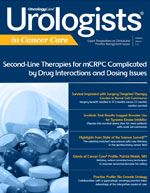The Future of Biomarkers in Prostate Cancer
At this year’s Chemotherapy Symposium held in New York, a standout presentation by Mark Stein, MD, showed that there is a lot of promise in the area of circulating tumor cell biomarkers for patients with prostate cancer.
Mark Stein, MD

Mark Stein, MD
At this year’s Chemotherapy Symposium held in New York, a standout presentation by Mark Stein, MD, showed that there is a lot of promise in the area of circulating tumor cell biomarkers for patients with prostate cancer. While this is an emerging and advancing development in research, biomarkers are not routinely used in clinical care. However, with advances in technology progressing as they are, the ability to sample cells, blood, and DNA that are in circulation are all likely to be integrated into routine care over the coming months and years, according to Stein.
The first use of circulating biomarkers in prostate cancer was to understand prognostic factors. However, isolating and characterizing circulating tumor cells is challenging, so instead, it is better to count these cells to see how many are present. By counting the circulating tumor cells, oncologists can use the count as a prognostic factor. Researchers have looked to see if these markers add anything to traditional markers such as CAT scans and prostate-specific androgen (PSA) tests. Results from the last few years have shown that biomarker assays do contribute to other tests, focusing mainly on counting the number of circulating tumor cells. Some of the newer technologies are even moving beyond this, and are looking at specific characteristics of the DNA in circulation.
Particularly when looking at some of the hormonal therapies, one of the main questions is whether there are certain predictors of response that could be sampled beforehand. If a patient has a lot of circulating tumor cells, it seems to be a rather poor prognosis factor, and can dictate the priorities of treatment. However, patients who have a decrease in the number of circulating tumor cells tend to do better, an early indicator of having a good response to treatment.
Investigators are even looking at utilizing biomarkers and counting circulating tumor cells as an endpoint in clinical trials. Typically, a trial will follow patients for survival, but this can take a long time and slow the trial down, making it more difficult to find answers to essential questions on patient treatment and care. The alternative, as studies are showing, is to use a decrease in circulating tumor cells as a clinical endpoint in a trial, rather than looking at survival. One focus is to look into whether changes in circulating tumor cells correlate so tightly with survival that, therefore, investigators can always choose it as a substitute, or a surrogate. Stein comments, “now, there are going to be additional trials going forward with circulating tumor cells being embedded into the trial, so that it is really definitively established that you can use those changes as a surrogate for overall survival, and, therefore, really expedite trial development.”
Another benefit to counting circulating tumor cells is that it can be done by taking a liquid biopsy, which requires a minimally invasive procedure that can be repeated, if necessary. This becomes especially helpful in situations where other tissues, such as bone, are not available, or could potentially cause the patient harm.
Another area of development is using changes in the androgen receptor to understand if tumors will still respond to hormonal therapies, specifically drugs like enzalutamide or abiraterone, which have become a routine part of practice for patients with castration-resistant prostate cancer. The response rate, although perhaps not zero, is present when patients have a mutation in the androgen receptor. Cells with a mutation in the androgen receptor do not respond under hormonal therapy, and potentially are an important mechanism of resistance. Identifying this mutation early would be invaluable in determining which therapy to use.
Androgen receptor mutations are the result of selective pressure, Stein explains. The receptor itself is the majority of the androgen receptor in the cell, and then under selective pressure, cells proliferate that are able to adapt to the presence of an androgen receptor inhibitor, such as enzalutamide. Stein adds, “What’s also interesting is that if you then—given the symptoms—give another treatment after, such as chemotherapy, you will see levels of the androgen receptor variants decrease, suggesting, again, that once the selective pressure is removed, that variant goes away.”
There are already commercially available tests looking at splice variants, so that is certainly something that can be useful, particularly if it becomes very difficult to understand whether a patient should go on a particular therapy or not.
So far, everything looks promising for looking at biomarkers in patients with prostate cancer, although more focused studies are always needed. “Once you have this biomarker,” comments Stein, “then you have to decide what you’re going to do with it. You certainly want direct additional therapies towards patients who might be in most need of additional treatment.”




